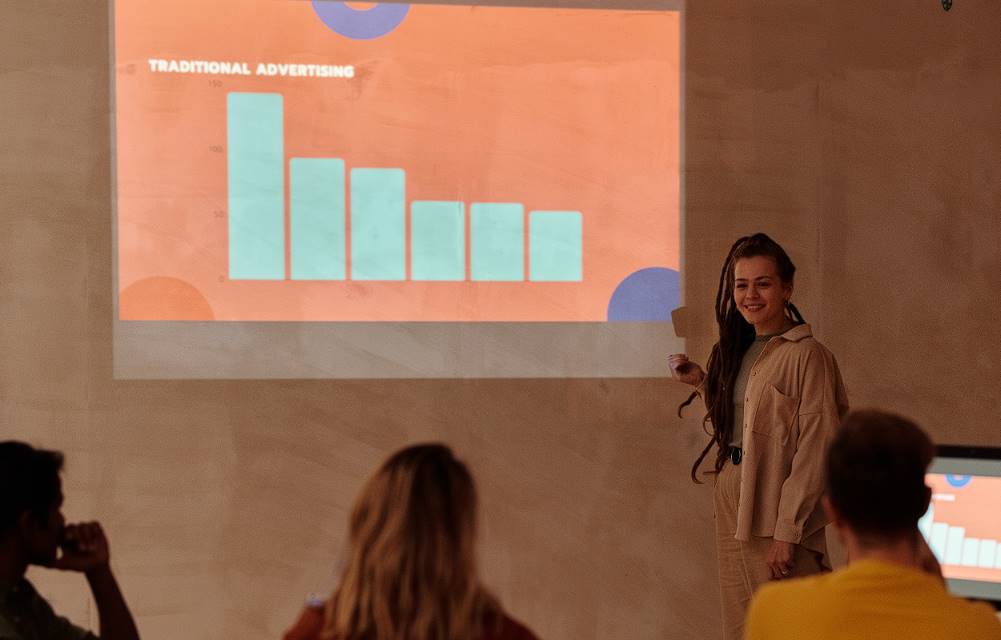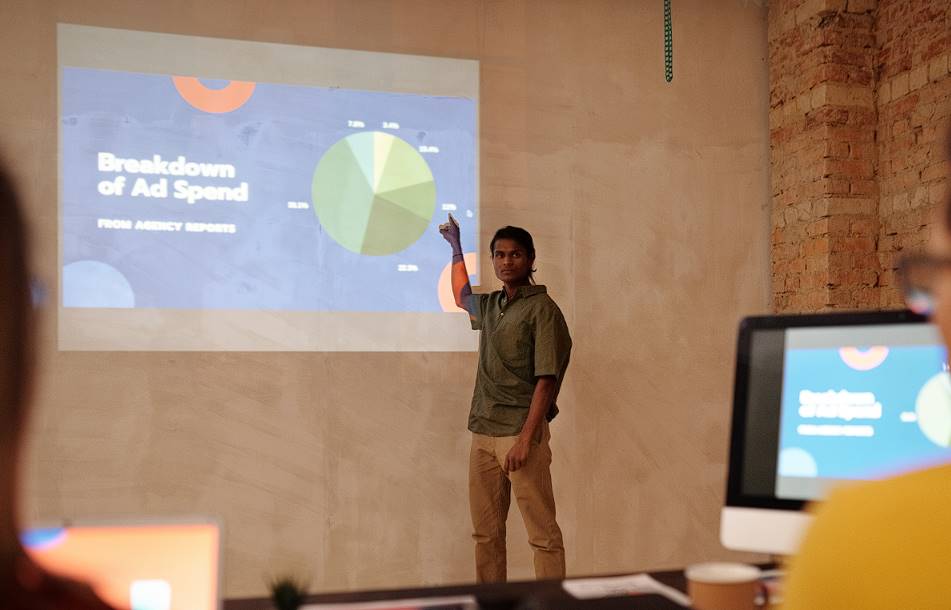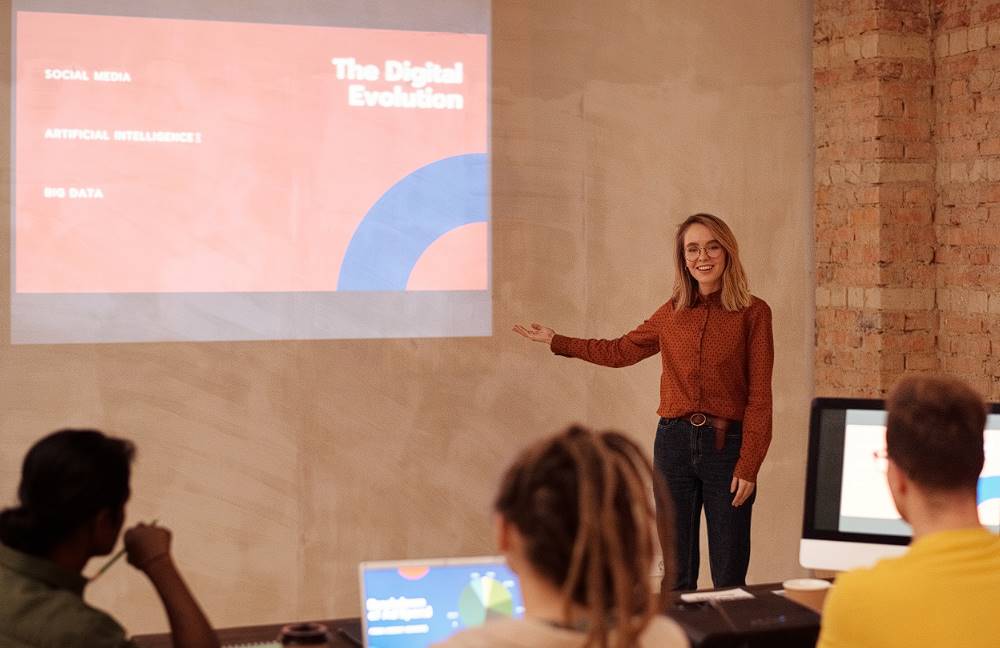At one point or another, we've all used Microsoft PowerPoint to create presentations. It's a popular tool in the business world, but can it be considered a data visualisation tool? In this article, we'll explore the capabilities of PowerPoint as a data visualisation tool and compare it to other options available on the market.
PowerPoint is primarily designed for creating presentations, not specifically for data visualisation. However, it does have some built-in features that allow users to create simple charts and graphs. These features include the ability to create bar graphs, pie charts, and line charts. While these are useful for basic data visualisation, they may not be suitable for more complex data sets.
To create more advanced data visualisations, users can use add-ins and plugins that expand the functionality of PowerPoint. Some popular options include Think-Cell, Power-user, and Office Timeline. These add-ins allow users to create more sophisticated charts and graphs and add additional features such as animations and interactive elements.
However, while PowerPoint can be used to create data visualisations, it is not the most powerful tool on the market. There are many other options available that are specifically designed for data visualisation, such as Tableau, QlikView, and Domo. These tools offer more advanced features and allow users to create more complex data visualisations with greater ease.
One of the biggest drawbacks of using PowerPoint as a data visualisation tool is that it can be time-consuming to create complex visualisations. Users may find themselves spending more time formatting and adjusting their charts and graphs than actually analysing the data. This can be especially problematic for large data sets or complex data analysis.
Another drawback of using PowerPoint as a data visualisation tool is that it can be difficult to keep data up-to-date. If changes are made to the underlying data, users will need to update their visualisations in PowerPoint manually. This can be time-consuming and error-prone and may lead to inaccuracies in the data.
Quick Links To Data Science Online Courses
RMIT Online
Graduate Certificate in Data Science
- 8 months intensive, part-time
- Jan, Mar, May, July, Aug, Oct
- $3,840 per course, FEE-HELP available
The University of New South Wales
Graduate Diploma in Data Science (Online)
- As little as 16 months
- 8 courses
- Study Intakes: January, March, May, July, September and October
James Cook University
Master of Data Science Online
- 24 months , Part-time
- $3,700 per subject , FEE-HELP is available
- 12 (One subject per each 7-week study period)
University Of Technology Sydney
Applied Data Science for Innovation (Microcredential)
- 6 weeks
- Avg 14 hrs/wk
- $1,435.00
Rules for Data Visualization in PowerPoint
PowerPoint is still widely used despite the rise of other presentation software such as Canva, Adobe Spark, and Google Slides. In fact, on April 20th, it will have been around for 35 years. If you had a Sony Walkman or Nintendo Gameboy from the same era, you might be surprised to see how well this middle-aged presentation media powerhouse has held up.
PowerPoint has evolved throughout the years to meet the evolving demands of the presenting industry, including adding data visualisation tools.

Use both Excel and PowerPoint
Regarding organising raw research, Microsoft Excel is an excellent tool. But, it is not something that you should use in the presentation that you are giving.
Excel data may be imported into PowerPoint, where it will be transformed into graphics that are not only more appealing but also simpler to comprehend. To begin, your data should be organised in Excel.
The next step is to open PowerPoint and make a new slide by selecting the graphs option when prompted to do so.
Choose the kind of graph that best suits your needs. When you have completed those steps, PowerPoint will display a chart menu that is similar to the one seen in Excel.
All you need to do to get your data into the PowerPoint chart from Excel is copy and paste. Your information will be shown in the form of the visual that you have selected automatically.
Examining the "Smart Graphics Sampler" that can be found in the menu labelled "Templates" is one of the easiest methods to get an idea of the data visualisation capabilities that are available in PowerPoint. This informative template provides a rundown of all the different things that may be accomplished using PowerPoint's smart graphics.
Define Your Purpose & Choose the Right Graphic
You must first have a clear understanding of the objective before you can make a compelling data visualisation in PowerPoint. Why are you making it in the first place? Who is it for? Which part of the story are you trying to get across?
At Ethos3, we adhere to the philosophy that the foundation of any compelling presentation and graphic is a compelling story. Spend some time writing out your account of the events. After that, you will be able to create data visualisations with meaningful content.
When you have determined your objective, it is time to select the appropriate graphic. Don't be intimidated by the extensive list of tools that are at your disposal. Check out this introduction to the various kinds of charts that can be used and how to apply them that were provided by wpDataTables.
For instance, if you want to compare your company or product to that of a competitor, you should probably go with a bar graph as your data presentation method of choice. A line graph, on the other hand, might be a more appropriate choice for illustrating change over time.
Know When to Customize
Don't be hesitant to customise the items you're developing when you're working on your data visualisations. PowerPoint's greatest strength is that it enables users to have creative control over the appearance of their graphics.
The majority of PowerPoint's intelligent visuals may be customised using the program presets. Such as the typical titles for the axes and the lines on the graph.
Know When Not to Customize
Although PowerPoint gives you the ability to personalise virtually everything about your data visualisations, it does not always imply you should. At least, not all of the time. Your whole slide deck should strive to have colours, fonts, sizes, and shapes that are all consistent with one another.
An effective PowerPoint presentation should never have the appearance of a patchwork quilt, in which each new slide looks very different from the one that came before it. Keep in mind that you need to tell a tale that flows well.
Keep Your Audience in Mind
A good data visualisation should always focus on the narrative that is being told and the audience that is being addressed. The above illustration shows the narrative of a corporation that is now reaching a greater number of clients than it ever has before.
Because I changed the size and colour of the 53%, it stands out from the rest of the data and draws the attention of the viewer. In addition, I changed the subject from something dull (the percentage of consumers that opened our email) to one that asks a question: What proportion of customers opened our email?
The correct answer is 53%, as can be seen. As presenters, it is our responsibility to make the data we offer to the audience as easy as possible to grasp. In an ideal scenario, with a single swift look.
How to Visualize Data Like a Pro
Have you ever been in a situation where a coworker handed you a file that was full of data, but you had no idea what the data meant?
Have you delivered that anxious grin and a weak "Excellent, thanks" in response to their request?
Wouldn't it be nice if you could avoid feeling overwhelmed altogether?
For this reason, effectively displaying data is of critical importance.
The value of data is contingent on the audience's ability to comprehend it.
Converting a jumble of data and statistics into a visual representation is one of the finest methods to comprehend the mess that the figures and statistics have created.
You will be able to develop the method of data representation that is both the most effective and the most efficient after you have a grasp of and have selected the medium that is the greatest fit for your data.
Keep in mind that there is a narrative hiding behind every statistic, and using a data visualisation ppt will assist you in effectively communicating that narrative.
What’s Your Story?
There is a purpose behind your desire to create a visual representation of your data. You have the intention of telling a narrative.
Tell me more about that tale. What do you hope others will learn by looking at your data?
Imagine for a moment that you are the sales manager of a booming company and that you are eager to discuss the latest marketing campaign that was a huge success. That's the way you tell it.
When you have a clear idea of what you want your data to convey, you'll have a better idea of how to display it.
What Type of Data Do You Want to Visualize?
The creation of a data visualisation PowerPoint presentation is an art form.
You are going to want to take a number of different considerations into account.
The most crucial consideration is the kind of information you wish to make public.
While beginning the process of visualising your data, one of the first steps you should do is to have an understanding of the types of data you have available.
If you know your narrative and take into account the kind of data you have, such as whether it is quantitative or qualitative, whether it is a large amount of data or a little amount, you will be able to choose which kinds of charts will express your message in the most effective manner possible.
While developing a data visualisation PowerPoint, the very last thing you should take is to open up a charting tool.
Choose the Chart Type That Will Communicate Your Message Effectively
Matching the sorts of data you have to the chart style that is most suited to display them is one of the most important steps in effectively visualising your data.
You want your data to be easily consumable, straightforward, and simple to comprehend.
Using a chart type that can successfully communicate your facts in a way that is both clear and concise will offer your narrative the greatest possible opportunity of being understood.
Know Your Audience
Last but not least, it is essential to have a solid understanding of your target demographic and the key takeaway you desire them to have after consuming your data.
- Which of these outcomes do you hope they will experience as a result of using your data?
- Are they already familiar with the material you're going to present?
- Are they engaged in the same line of work as you?
- Are they interested in the ways in which the statistics you're providing are related to one another?
As a storyteller, one of your goals should be to hold the interest of your audience.
You are relying on images to convey the message rather than utilising words to do it.
When it comes to visually representing quantitative data, a picture is worth far more than a thousand words.
In a contrast to making an effort to describe the data and temporal relationships via the use of words, for instance, a pattern or trend may be clearly displayed through the use of a straight line graph.
When data is presented in its raw form, it leaves itself up to being interpreted in a variety of ways by the person who receives it.
Use the power of data visualisation to convey an engaging tale if you want to lead the conclusion that your audience arrives to. This is especially important if you want to lead the conclusion.
Know your narrative, know your audience, know your data, and select the best media to express your concept in the simplest manner possible. Knowing your story, knowing your audience, and knowing your data will help you choose the ideal medium.
If you can adhere to these four golden guidelines, you will have mastered the art of creating data visualisations in PowerPoint.
Pick the Chart Types That Will Communicate the Message Effectively
Matching data types to the most appropriate chart designs is the key to effectively displaying data and making it easy to comprehend. With PowerPoint, a variety of chart types are available for usage.
Create many charts using the same data if you are unsure on what chart format to use. The alternative that appeals to you and presents the facts rationally will be the best choice.
Since they add excitement to presentations and give the audience useful information, PowerPoints are an excellent tool for businesses. The audience must be able to comprehend the significance of what you are saying or showing them, though, for the knowledge to be valuable.
This is why employing data visualisation in PowerPoint is so crucial. Charts and data have long been significant components of PowerPoint presentations. PowerPoint needs data visualisation since failing to grasp the data you are presenting in your presentation might cause you to lose your audience quickly.
It is not necessary for data visualisation to be difficult or time-consuming. You may quickly add graphs to your PowerPoint presentation using a straightforward application. Data is a fantastic approach to conveying information and aids with audience comprehension.
How to Use Powerpoint for Data Visualization
PowerPoint is a powerful application that may be used to display data.
While running a business, it is often necessary to exchange data with several parties, such as employees, managers, suppliers, or even shareholders.
Instead, teachers at schools can be required to present data to their classes so that students might review and analyse it.
You are able to successfully deliver this material in a way that is intriguing and engaging by making use of a PowerPoint presentation.
PowerPoint makes it possible to import graphs, charts, and tables created in other applications, such as Microsoft Word and Microsoft Excel, for use in presentations.
In addition, you have the ability to enter pictures that have already been developed, such as infographics or pictograms.
Because of this, the presenter is able to provide helpful info in a visual format that is straightforward to comprehend.
With the use of a PowerPoint presentation that makes use of data visualisation, the presenter will have the ability to communicate their facts with their audience simply and will also create a visual focal point for them to concentrate on.

Why Should Your Business be Using PowerPoints?
PowerPoint first appeared in May of 1990 and has been widely utilised in commercial settings ever since its inception.
PowerPoint may not be the only tool or piece of software accessible in the modern day, but it is still frequently suggested for use in commercial settings. The use of PowerPoint is highly recommended for a number of reasons, the most important of which are outlined here.
It is Professional Looking
PowerPoint presentations are utilised by thousands of organisations across the world each year due to the fact that PowerPoint was developed with business needs explicitly in mind. You may utilise one of the numerous pre-set slides that are available to you, or you can design your own presentation from.
Either choice can result in designs that give the impression of being professionally done. This presents an opportunity for smaller firms, particularly those that may not appear as professional as their bigger counterparts, to profit.
Helps Keep Your Audience Focused
It is much easier to comprehend information when one can both hear and see what is being said by another person. It also helps people stay their attention for longer since you may utilise photographs, videos, animation, and charts to keep your audience engaged in your presentation.
This helps people keep their attention for longer. Checking out one of the numerous tutorial videos that are available online is a great idea, particularly if you are seeking a certain style or layout.
PowerPoints are a Great Option for Organizing your Ideas and Thoughts
At some time in our lives, each and every one of us will forget an essential topic when giving a presentation. PowerPoint gives you the ability to have all of your essential points defined for you, making it more difficult to forget a vital point in your presentation.
Because it makes it easier for you to stay on topic and concentrate on your ideas, they may also assist you in delivering a presentation that is of a higher quality.
In addition to this, it serves as an excellent blueprint to follow. Because of this, the amount of time that you will spend babbling will be reduced, allowing you to maintain your schedule.
Conclusion
In conclusion, while PowerPoint can be used as a data visualisation tool, it is not the most powerful option available on the market. It is best suited for simple visualisations and may not be suitable for more complex data sets. Users who require more advanced data visualisation capabilities may want to consider using a tool specifically designed for that purpose.
Data visualisation should be easily consumable, straightforward, and simple to comprehend, with a chart type that can successfully communicate facts in a way that is both clear and concise.
Knowing your story, audience, and data will help you choose the ideal medium. PowerPoint is a powerful application that can be used to display data and make it easy to comprehend, making it an excellent tool for businesses.
Four golden guidelines for data visualisation include picking the right chart types, matching data types to the most appropriate chart designs, importing graphs, charts, and tables from other applications, and using pictures that have already been developed.
PowerPoint is highly recommended for commercial settings due to its professional look and ability to create a visual focal point. PowerPoints are a great option for organising ideas and thoughts but are not the most powerful option for data visualisation.
Content Summary
- In this article, we'll explore the capabilities of PowerPoint as a data visualisation tool and compare it to other options available on the market.
- However, while PowerPoint can be used to create data visualisations, it is not the most powerful tool on the market.
- One of the biggest drawbacks of using PowerPoint as a data visualisation tool is that it can be time-consuming to create complex visualisations.
- Another drawback of using PowerPoint as a data visualisation tool is that it can be difficult to keep data up-to-date.
- Regarding organising raw research, Microsoft Excel is an excellent tool.
- To begin, your data should be organised in Excel.
- All you need to do to get your data into the PowerPoint chart from Excel is copy and paste.
- Examining the "Smart Graphics Sampler" that can be found in the menu labelled "Templates" is one of the easiest methods to get an idea of the data visualisation capabilities that are available in PowerPoint.
- Define Your Purpose & Choose the Right Graphic You must first have a clear understanding of the objective before you can make a compelling data visualisation in PowerPoint.
- For instance, if you want to compare your company or product to that of a competitor, you should probably go with a bar graph as your data presentation method of choice.
- Don't hesitate to customise the items you're developing while working on your data visualisations.
- Know When Not to Customize Although PowerPoint gives you the ability to personalise virtually everything about your data visualisations, it does not always imply you should.
- A good data visualisation should always focus on the narrative that is being told and the audience that is being addressed.
- Remember that there is a narrative hiding behind every statistic, and using a data visualisation ppt will assist you in effectively communicating that narrative.
- There is a purpose behind your desire to create a visual representation of your data.
- You have the intention of telling a narrative.
- When you have a clear idea of what you want your data to convey, you'll have a better idea of how to display it.
- The creation of a data visualisation PowerPoint presentation is an art form.
- Matching the sorts of data you have to the chart style that is most suited to display them is one of the most important steps in effectively visualising your data.
- Use the power of data visualisation to convey an engaging tale if you want to lead the conclusion that your audience arrives to.
- Know your narrative, know your audience, know your data, and select the best media to express your concept in the simplest manner possible.
- Knowing your story, knowing your audience, and knowing your data will help you choose the ideal medium.
- If you can adhere to these four golden guidelines, you will have mastered the art of creating data visualisations in PowerPoint.
- Matching data types to the most appropriate chart designs is the key to effectively displaying data and making it easy to comprehend.
- This is why employing data visualisation in PowerPoint is so crucial.
- It is not necessary for data visualisation to be difficult or time-consuming.
- With the use of a PowerPoint presentation that makes use of data visualisation, the presenter will have the ability to communicate their facts with their audience simply and will also create a visual focal point for them to concentrate on.
- PowerPoint may not be the only tool or piece of software accessible in the modern day, but it is still frequently suggested for use in commercial settings.
- The use of PowerPoint is highly recommended for a number of reasons, the most important of which are outlined here.
- You may utilise one of the numerous pre-set slides that are available to you, or you can design your own presentation.
- PowerPoint gives you the ability to have all of your essential points defined for you, making it more difficult to forget a vital point in your presentation.
- Conclusion In conclusion, while PowerPoint can be used as a data visualisation tool, it is not the most powerful option available on the market.
- Users who require more advanced data visualisation capabilities may want to consider using a tool specifically designed for that purpose.
Frequently Asked Questions
Data visualisation tools are software applications that render information in a visual format such as a graph, chart, or heat map for data analysis purposes. Such tools make it easier to understand and work with massive amounts of data.
Excel is one of the best data visualisation tools for businesses and professionals. However, this freemium spreadsheet tool has very basic charts and graphs, such as Pareto and Grouped Bar Charts.
With PowerPoint on your PC, Mac, or mobile device, you can: Create presentations from scratch or a template. Add text, images, art, and videos. Select a professional design with PowerPoint Designer.
You can use PowerPoint for graphic design, and it's not that hard! Removing backgrounds from images, blurring images, creating custom shapes, and converting text to shapes are just some of the ways you can use PowerPoint for graphic design.
PowerPoint is a valuable communication aid that is now being used in many classrooms. PowerPoint is a type of presentation software that allows one to show coloured text and images with simple animation and sound. PowerPoint is just one of many types of presentation software.





